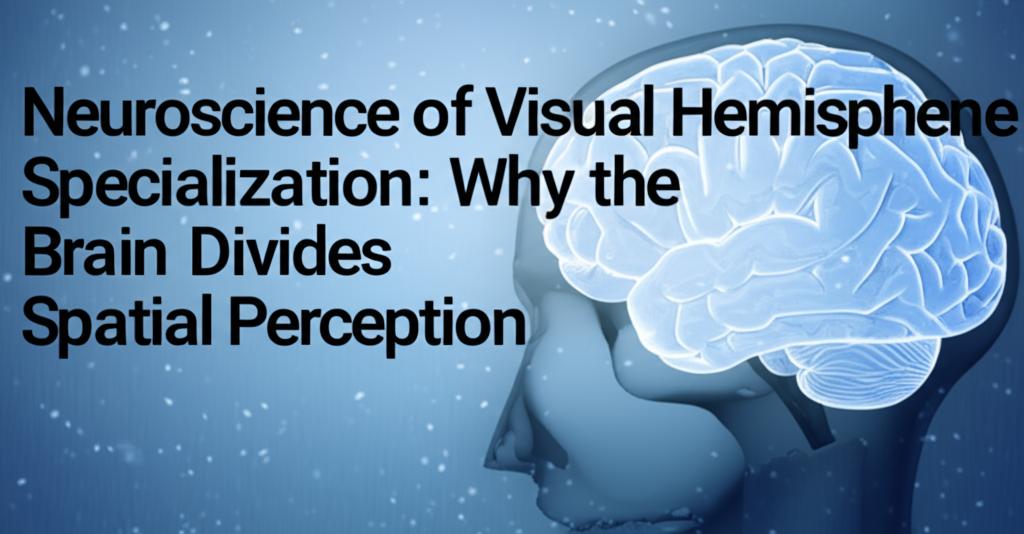While the left-brain/right-brain concept is often oversimplified into popular myths about analytical versus artistic thinking, research confirms a genuine division of labour between the hemispheres, particularly in visual spatial perception. This specialization is not about one hemisphere being solely responsible for certain broad traits, but rather a strategic allocation of resources by the brain to optimize its perceptual capacity.
The Contralateral Advantage: Splitting to See MoreA fundamental principle of neuroscience is that visual information from one side of our visual field is primarily processed by the opposite brain hemisphere. What you see on your left is processed by your right hemisphere, and what's on your right is processed by your left hemisphere. This contralateral processing isn't just an early-stage phenomenon; it extends even into higher-level cognitive functions in the prefrontal cortex, such as attention and working memory.
The primary reason for this division is to enhance our overall perceptual capacity. Our ability to take in and process visual information at any given moment is limited. By dividing the work, with each hemisphere focusing on the opposite side of our gaze, the brain effectively doubles its resources. This "bilateral advantage" helps prevent perceptual blind spots and attentional overload, which is especially crucial when tracking multiple objects or monitoring for potential threats from different directions. If all our perceptual capacity were focused on one side, we might miss important information on the other.
Not a Total Split: Selective SpecializationIt's important to note that this hemispheric split for visual information is specific to spatial information – the "where" of an object. Other features, like the colour or shape of an object, are typically processed by both hemispheres. This indicates a sophisticated system where the brain selectively lateralizes functions for maximum efficiency.
Seamless Coordination: Bridging the DivideDespite this division, our perception of the visual world is remarkably seamless. When an object moves across our field of vision, we don't experience a "jump" as processing hypothetically switches from one hemisphere to the other. This is because the brain has mechanisms for smooth "handoffs." As an object approaches the midline of our vision, the receiving hemisphere begins to increase its activity in anticipation, while the sending hemisphere maintains its engagement for a short period even after the object has crossed over. This overlapping activity, which can last up to a second, ensures a continuous and unified visual experience. There is, however, a small processing cost associated with this neural coordination.
Beyond Basic Perception: High-Level Functions and Individual DifferencesContrary to earlier theories that suggested the prefrontal cortex fully integrated spatial information from both hemispheres, more recent research, including studies measuring brain waves (like gamma frequency power), shows that even in these advanced processing areas, a bias towards contralateral processing of spatial information persists. The hemispheres can function with surprising independence for tasks like attention and working memory. Studies have demonstrated that people can often remember more items if they are presented across both visual hemifields (and thus processed by different hemispheres) compared to when all items are clustered on one side.
Furthermore, individuals can exhibit differences in their perceptual capacity across their visual field. Understanding these individual variations in how spatial information is processed by each hemisphere could have practical applications, for example, in optimizing performance in visually demanding and complex tasks.
Evolutionary and Developmental PerspectivesThe specialization of brain hemispheres, or lateralization, is thought to provide an evolutionary advantage. By allowing for parallel processing of different types of information (like visuospatial information in one hemisphere and language processing predominantly in the other), the brain can operate more efficiently and reduce redundancy. This division may also enhance the ability to perform multiple tasks simultaneously and prevent response competition between the hemispheres.
From a developmental perspective, there's evidence that the brain's lateralization for functions like spatial processing isn't fixed from birth but develops over time. Young children might show more bilateral activation for tasks that become more strongly lateralized in adults. This suggests a gradual refinement of hemispheric specialization as the brain matures.
In summary, the brain's division of spatial perception between its hemispheres is a sophisticated strategy to maximize perceptual capacity, improve efficiency, and enhance cognitive functions like attention and memory. While operating with a degree of independence, the hemispheres seamlessly coordinate their activity to provide us with a unified and continuous experience of the visual world. This fascinating aspect of brain function highlights the intricate ways our brains are wired to interact with and understand our surroundings.

